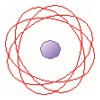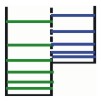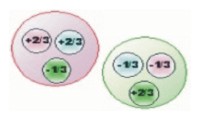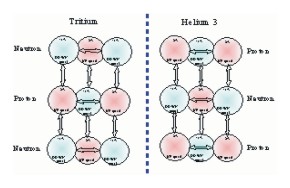

Current Models of the Nucleus
The primary models of the nucleus include the cluster, liquid drop, shell and lattice models.

1. The Cluster Model was one of the earliest models and was developed because for the lighter nuclei the binding energy peaks when there are sufficient numbers of protons and neutron in the nucleus to form an integer number of alpha particles. It was also noted that heavier nuclei decomposed by emission of alpha particles rather than by emission of individual protons or neutrons. However this model poses problems when the neutrons out numbers the protons. This anomaly was unexplainable and thus the cluster model fell out of favor.

2. The Liquid Drop Model is based on the strong nuclear force being attractive and is non selective for nucleons. Based on the assumption that the strong force indiscriminately pulls all nuclear particles together like water molecules in a liquid drop. The nature of the strong force does not provide any perceptible way to impose structure on a nucleus other than what would occur within a liquid drop. The liquid drop model explains nuclear density and partially explains fission but has problems with asymmetrical fission. It also does not address adequately the discrepancy between numbers of protons and neutrons in the nucleus.

3. The Shell Model developed to explain different energies levels observed for nuclei and in an effort to explain what appeared to be magic number of nucleons. This model is popular because it mimics the structure to the electron shells of the atom. There are five glaring problems withthe shell model. First, there is no central force for the shells to from around like the electrons form around the positive nucleus. Second, the mean free path of particles in the nucleus are to short to permit the formation of shells. Third, why are there different potential wells for protons and neutrons. Fourth, the shell model does not explain fission and it is even more vague about asymmetrical fission. Fifth, The failure to find an island of stability beyond the uranium island.
4. The Combination Model is where the liquid drop and shell models are alternative and in combination to address different questions about the nucleus. However, in those cases the liquid drop and shell models are diametrically opposed to each other. Even using this combination model there are several interesting anomalies that neither the shell nor the liquid drop model can address or explain. The most obvious case where they are diametrically opposed is the mean free path problem. The most glaring problem is that neither model can provide an adequate answer for asymmetrical fission.

5. The Lattice Model was developed in an attempt to reconcile and combine the strong points of the liquid drop and shell models. The strong points being that nuclear density of the lattice is similar to the liquid drop which is the measured density of the nucleus. The different energy levels represented by various shells levels can also be developed from slight permutations, perturbations, variations, or anomalies in a lattice structure.

6. The earliest Quark Model originally tried building a nucleus base solely on quarks and the strong color force and tried to explain the nucleus without regard for the effects of protons and neutron par say. No proposed quark based model has been viable because they only considered the strong force.

7. The latest Combination Model is a combination of the lattice and quark models.
X. The model presented in this paper might best be called a quark lattice model. This sound like a complex model but in reality it is simpler than all but the liquid drop model.
The model in this presentation, is based on the premise that
quarks
remain confined in the nucleons (protons and neutrons)
but the
quark do affect how the nucleons interact
based
on the fact that three quarks will form a triangle and not a sphere
and the
quarks have an electric charge and magnetic dipole that align.
Thus, as
a result the nucleons form a lattice structure.

Thus this model could be referred to as a, Nucleon Based, Quark Controlled, Lattice Model which builds the nucleus using protons and neutrons but considers the effects of the quarks electrical and magnetic dipoles on how nucleons attach to each other and the nuclear structure that results when nucleons are laid down in an organized manner. Not to leave out anything the structure that results is based on the shape of the alpha particle.
You will realize following the development of this model, why all the other models developed because in some aspect they all contain part of the correct answer.